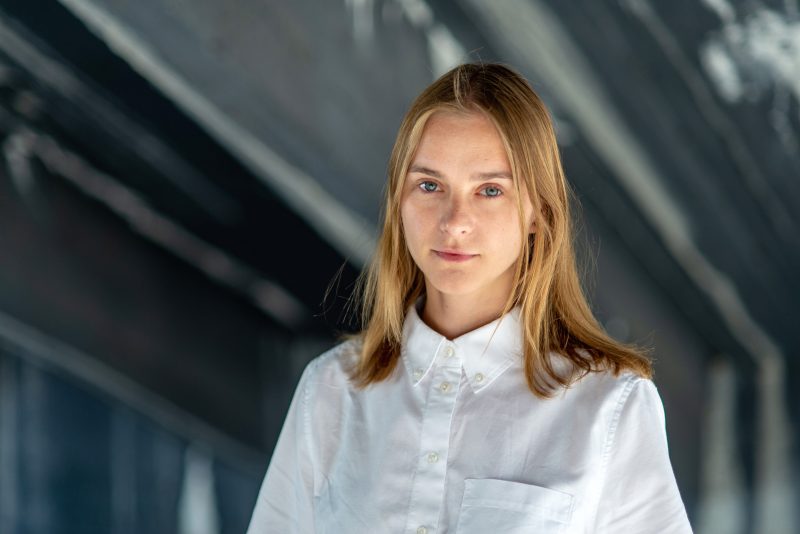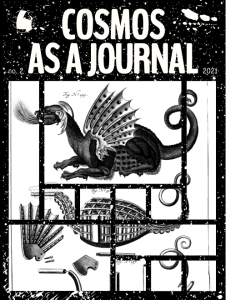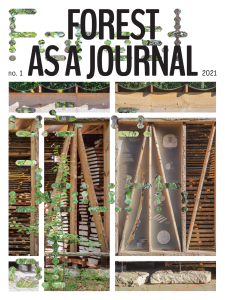The Lithuanian Culture Institute presents a new, so far the fourth issue of the art and culture magazine * as a Journal, published in English. Author and member of the artist duo Pakui Hardware Neringa Černiauskaitė, who curated the issue titled Body as a Journal, brought together as many as 16 philosophers, researchers, curators, activists and artists from Lithuania and other countries to delve deep into the theme of corporeality. Produced by an international team, the issue draws on the visual and interdisciplinary arts, dance, language studies, literature and other cultural fields, as it explores the topics of medicine, economics, politics, sexuality, war, magic and technology.
Neringa Černiauskaitė opened the theme of corporeality
The magazine, which is currently in the third year of its existence, changes its title along with each core topic. Until now, Lithuanian and foreign readers were able to delve into the explorations of forest, space and soundscape phenomena. The current issue offers an in-depth look into corporeality. The magazine’s editorial board, consisting of Vaiva Grainytė, Adomas Narkevičius, Rūta Statulevičiūtė-Kaučikienė and the magazine’s editor Kotryna Lingienė, invited Neringa Černiauskaitė to ponder and present this subject. Neringa Černiauskaitė and Ugnius Gelguda are known in Lithuania and abroad as the Pakui Hardware duo, who in their work explore body plasticity and transformations. The duo, together with Marija Teresė Rožanskaite (1933-2007), will examine these themes further in the Lithuanian pavilion at the Venice Biennale in 2024.
The conceptual axis of the new issue is the vulnerability of the body
Body as a Journal focuses on the physical, social, economic and ecological vulnerability of the body, which the issue regards as a uniting and empowering factor. In Černiauskaitė’s opinion, the topics of corporeality and vulnerability are currently extremely relevant: in recent years, art biennials and magazines published around the world have been probing those. According to the curator, the existing critical considerations were exacerbated by the war that started in Europe last year.

“The body is an inexhaustible topic, which keeps deepening with the changing world, its discoveries and new challenges,” says the guest editor. “The Lithuanian Culture Institute invited me to compile the issue of Body as a Journal last April, less than two months after Russia’s invasion of Ukraine. Thus, inevitably fragility and vulnerability became the prism through which the body is explored in this issue. Being vulnerable means being open, and not necessarily in a negative sense. Vulnerability can become a delicate bridge leading to mutual understanding and empathy. At the same time, we wanted to emphasise that vulnerability is usually systemic, affecting certain groups in society more than others. Therefore, this magazine issue explores several threads of vulnerability: the fragility of the physical body, social, economic and ecological precariousness and the search for new opportunities in fragility.

Member of the editorial board, curator Adomas Narkevičius reflects on the theme of corporeality through the work of photographer Virgilijaus Šonta. “I had the pleasure of contributing to Body As Journal not only in my usual role as a member of the editorial board but also by reflecting on the meaning of passion for men and the unrestrained homo-eroticism in the photographic legacy of Virgilijius Šonta. The embodied perception of oneself, as well as the other and the surrounding environment as embodied – only differently – is a promise of sensitive coexistence and an attempt to act in the name of all things fragile. I believe that the texts and images presented in this issue will be perceived by the readers as shining light on our multifaceted corporeal reality and as promises of embodied action,” says Narkevičius.
The issue’s polyphonic narrative was weaved together by philosophers, theoreticians, artists and AI
“It was extremely important for me to create a polyphonic and multicultural narrative, so I am delighted that prominent Lithuanian and international philosophers, theoreticians, writers and artists responded to the invitation to write texts or engage in conversations as part of the issue,” shares Černiauskaitė. “The theme of vulnerability allowed us to interweave theoretical thinking with presentations by contemporary and historical artists, interspersed with literary and visual narratives. This kaleidoscope of material was skillfully bound together by designer Vytautas Volbekas.”
The core theme of the issue opens with the interview by Kaunas-based curator and artist Agnė Bagdžiūnaitė with the University of California medical professor, physicist, activist and artist Rupa Marya, who is also a co-author of the book Inflamed: Deep Medicine and the Anatomy of Injustice. Professor explains how colonial capitalism and the thinking that underpins and emanates from it produces inflamed bodies. The conversation is conceptually echoed by poet and writer Vaiva Grainytė’s poem Waiting for the Gastroenterologist and the poetic text Roots by writer and curator Monika Kalinauskaitė, dedicated to her mother.
Readers of Body as a Journal will be introduced to Lithuanian and foreign artists and prominent intellectuals. In this issue, Inga Lāce, a researcher and curator at New York’s MoMa museum, analyses how medical technology is pondered in the early works of Marija Teresė Rožanskaitė and the contemporary pieces of the Pakui Hardware duo. The topic of corporeality and vulnerability of the body also takes centre stage in philosopher Kristupas Sabolius’ conversation with philosopher Catherine Malabou, professor at Kensington University, about ideas of plasticity, anarchy and anarchism she has been developing. Jurga Jonutytė, researcher at Vytautas Magnus University, and artist Gabrielė Gervickaitė talk about experiences of vulnerability embodied in creativity.

Agnė Jokšė, an artist working in Copenhagen and Vilnius, analyses fossilised, heteronormative forms of the Lithuanian language. Adomas Narkevičius, the curator of London’s Cell Project Space, introduces readers to the homo-erotic works of photographer Virgilijus Šonta, created in a comprehensively restrictive Soviet context. Eric Vautrin, the playwright, theatre critic and theoretician of the Swiss Théâtre Vidy-Lausanne, presents to the readers the routines that arise from suffocating social practices reflected in the work of Anna-Marija Adomaitytė, choreographer and founder of the A MA dance troupe.
University of Oregon professor Stacy Alaimo and Paris-based Texan curator and writer Jennifer Teets consider the impact of economic, political, social, and natural forces on humans, flora and fauna. London-based writer Alice Bucknell examines the diverse artistic practices of Dorota Gawęda and Eglė Kulbokaitė, which combine themes of ecology, technology, science, magic and non-human intelligence. Bucknell wrote her article together with GPT-3, a natural language processing (NLP) programme, presenting the parts written by artificial intelligence in italics.
The issue concludes with the essay Brutal Poetics of Dizzinformation by curator and writer Valentinas Klimašauskas, in which he examines the propaganda machine of the Russian military invasion of Ukraine and the resistance to it.
Body as a Journal also includes reproductions and documentation of works by Anna-Marija Adomaitytė, Pakui Hardware, Naomi Rincon Gallardo, Dorota Gawęda and Eglė Kulbokaitė, Gabrielė Gervickaitė, Arthur Jafa, Agnė Jokše, Lewis Hammond, Anu Põder, Marija Teresė Rožanskaitė and Virgilijus Šonta. A fragment of the sculpture Tongues by the Estonian artist Anu Põder (1998) appears on the cover.
Art and culture magazine * as a Journal is published by the Lithuanian Culture Institute since 2021. The publication offers a unique space for cultural cooperation, where artists, curators and researchers from Lithuania and abroad meet to ponder universally relevant topics, inviting readers to consider those from unexpected cultural perspectives. The previous three issues were dedicated to the themes of forest, space, and soundscape respectively. The upcoming fifth issue will reflect on the theme of historical memory.
-
 Body as a Journal15.00€
Body as a Journal15.00€ -
 Soundscapes as a Journal15.00€
Soundscapes as a Journal15.00€ -
 Cosmos as a Journal15.00€
Cosmos as a Journal15.00€ -
 Forest as a Journal15.00€
Forest as a Journal15.00€

